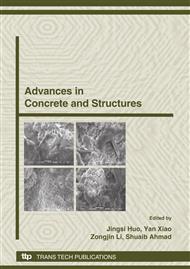p.893
p.901
p.911
p.917
p.923
p.929
p.935
p.943
p.949
A Comparative Research on Thermal Stresses Calculated from Different Element Models of a Concrete Continuous Box-Girder Bridge
Abstract:
According to the definition about the positive and negative gradient temperature distribution of structural cross section in the Chinese bridge design specification of General Code for Design of Highway Bridge and Culverts (JTG D60-2004), same temperature loads are applied to beam model and solid model of a typical there-span prestressed concrete continuous box-girder bridge to compare the numerical results of thermal stresses calculated from the two finite element models. The beam model is built through professional software Doctor Bridge that is prevailing in China for structural static analysis of bridge design, while the solid model is built using ANSYS. Between the two models, the numerical results of total thermal stress regarded to be added up with self-restrained stress and secondary stress are compared. The results from solid model are found to be much more conservative than from element model. The identity and diversity of the two series of results and the reasons for the generation of the diversity are expounded. It is recommended that the thermal stress calculated from solid model be better to be taken into account in a design so as to examine or amend the results that calculated through the professional software based on bar system FEM theory.
Info:
Periodical:
Pages:
923-928
Citation:
Online since:
October 2008
Authors:
Price:
Сopyright:
© 2009 Trans Tech Publications Ltd. All Rights Reserved
Share:
Citation:


